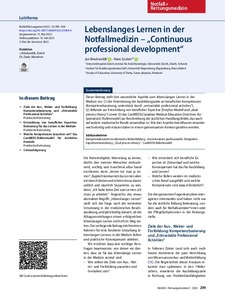Lebenslanges Lernen in der Notfallmedizin – „Continuous professional development“ (Life-long-learning in emergency medicine – Continuous professional development)
Breckwoldt Jan; Gruber Hans
https://urn.fi/URN:NBN:fi-fe2022091258630
Tiivistelmä
Dieser Beitrag stellt drei wesentliche Aspekte zum lebenslangen Lernen in der Medizin vor: (1) die Orientierung der Ausbildungsziele an beruflichen Kompetenzen (Kompetenzbasierung, unterstützt durch „entrustable professional activities“), (2) Befunde zur Entwicklung von beruflicher Expertise (Dreyfus-Modell und „dual process theory“) sowie (3) das CanMEDS(Canadian-Medical-Education-Directives-for-Specialists)-Rollenmodell zur Beschreibung der ärztlichen Handlungsfelder, das auch auf andere medizinische Berufe anwendbar ist. Alle drei Aspekte beeinflussen einander wechselseitig und müssen daher in einem gemeinsamen Kontext gesehen werden.
This contribution outlines three essential aspects of lifelong learning in the medical professions: (1) the orientation of learning objectives towards outcomes necessary for independent practice in the professional field (competency-based medical education [CBME], supported by the concept of entrustable professional activities [EPAs]), (2) findings on the development of professional expertise (building on the Dreyfus model of expertise and the dual process theory), and (3) the Canadian Medical Education Directives for Specialists (CanMEDS) roles framework for describing physicians' professional competencies (which might be extended to other healthcare professions). All three aspects interact with each other and should not be regarded as being independent.
Kokoelmat
- Rinnakkaistallenteet [27094]
